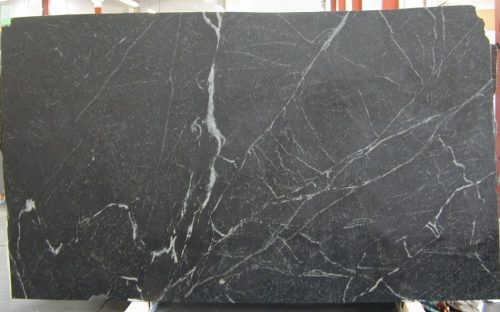
Soapstone provides a natural, rustic look that people adore. We do not want people counting soapstone out based on nonfactual reasons, so we are busting 10 myths about this material!
1. Soapstone turns green
This is a very common misconception about soapstone. It can be found with a green hue, but it does not turn green. If soapstone is purchased in grey, it will typically stay grey. Unless green tinted soapstone is originally installed, there should be no concern of ending up with green coloring over time.
2. Soapstone does not hold up well over time
Soapstone is one of the softer stones, so it is susceptible to scratches. Despite this, because of its extreme density and forgiving oil finish, scratches are not often problematic. Minor scratches tend to even disappear on their own and deeper marks can be sanded away. A new coat of mineral oil has the ability to refresh and blend the stone. Some consider soapstone especially unique in that it tends to look even better over time.
3. Soapstone only comes in grey
Soapstone is most commonly seen in shades of grey. However, it is not limited to only grey. Soapstone is offered in black, as well as hues of blues and greens. The color options of this stone come in a larger range than most people think they do.
4. Soapstone is unsafe to prepare food on
This stone is nonporous, giving dirt and germs no crevices to lodge into. Soapstone’s remarkably dense composition actually makes it so that little or no absorption can take place. In fact, soapstone has been the choice of chemistry laboratory tops for many years because acids and other chemicals do not stain or absorb into the stone. As this material is easy to clean and does not harbor dirt and germs, it is highly safe for food preparation.
5. Soapstone is man-made
Like marble and granite, soapstone is a natural stone. It is produced by the Earth, so each slab has its own sense of individuality. This material is not constructed in a factory, but by nature itself.
6. Soapstone comes in small slabs, which are limiting to design
Small slab sizes have little impact on design options due to the tight and barely visible seams that are possible with soapstone. Slabs are bonded with colored stone epoxy and sanded to create a seamless look.
7. Soapstone is unfit for fireplaces
Soapstone is unique in that it actually absorbs heat. A key factor that makes this stone so well-suited for fireplace surrounds is that it does not only absorb some of the heat and protect the walls around the fireplace, but it will also let the heat out slowly over time. This allows it to continue heating a home even after the fire has been put out.
8. Soapstone must be sealed
Because granite requires a sealer, people often assume that soapstone does as well. In contrast to common belief, soapstone is non-porous and, therefore, does not require a sealer at all.
9. Soapstone requires special cleaning products
Soapstone is chemically inert. This means that no special stone cleaner is needed. Certain cleaners may damage granite or quartz, but soapstone, on the other hand, is not selective when it comes to stone cleaners.
10. The softness of soapstone is a major drawback
Yes, soapstone is a softer stone. For this reason, it is easier to cut without worrying about cracks or breaks. A large price factor for granite is that slabs often crack during cutting; However, cracks are much less common with soapstone, which helps keep the cost down. It also means that soapstone can typically be cut into a wider variety of shapes and dimensions than other natural stone options can. Instead of viewing the softness of this material as a drawback, it can be viewed as a benefit.
If any of the above myths caused you to be suspicious of soapstone, we hope that busting them helped your view of this material. Part of our job is to help you stay informed with accurate information regarding countertops!
